Archive for the ‘Uncategorized’ category
Analyzing the science behind dancers’ artful movements
But a shared interest in the science behind movement ultimately led to a research collaboration between a former collegiate wrestler, Dr. Jim Hackney, and a former professional dancer, Sara Brummel.
“The demands of dance and the demands of sports are similar,” Hackney said. “However, many sports are a matter of what you’re doing with something else, rather than how you appear doing it. With a few exceptions, in sports the important thing is what you do with a ball. You get the ball into the basket, or get the ball over the goal line. I like dance best because it is a celebration of physicality for the sake of physicality.”

To explore how different dance surfaces affect the amount of force dancers’ joints have to absorb as they leap and land, Hackney, an associate professor of physical therapy, and Brummel, an associate professor of dance, collaborated on multiple research projects, which were supported by Harlequin Floors. The support they received allowed them to offer scholarships to dance majors who participated in dance biomechanics research.
Dynamics of dance
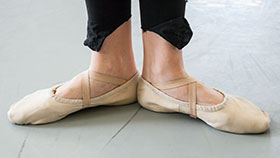
For their research, Hackney used a sports motion program to analyze dancers’ movements, and the Pedar insole system to measure the amount of force they absorbed as they landed on traditional surfaces compared with sprung floors.
“We looked at the lower extremity, the leg and foot, and the way it absorbs forces when jumping and landing on a hard floor, versus a floor that has a bit of give to it,” Hackney said. “As the surface displaces, the lower extremities have to give less. What this is showing is that the legs and feet of the dancers don’t have to absorb as much of the force because the floor is absorbing some of it instead.”
Though dancers are known for their seemingly effortless ability to glide through the air and pivot on the tips of their toes, Brummel and Hackney note that dancers’ bodies are working hard in each move. They must stiffen joints, adjust trajectories and absorb forces without consciously thinking about it.
“When you watch a group of dancers jumping on a sprung floor, you can see the floor moving.” — Sara Brummel
“First of all, in the takeoff, a dancer needs to produce enough energy from her supporting leg to accelerate against gravity, so that the lift-off force exceeds gravity,” Hackney said. “Then, she needs to generate sufficient stiffness in the joints of her lower body to keep from collapsing. If there were no stiffness of the joints in her lower extremity and trunk, she would collapse into a heap on the ground.”

Inspired by the mechanics behind movement
“I think we live in a society where it’s often considered that everything that is important about us is from the neck up, and this body is just something that I cover with clothes and schlep around,” Hackney said. “Physical therapy is really an exploration of not only the neck up, but also the neck down as well; considering the person as an integrated whole. I was drawn to dance because it is a celebration of the physicality of our humanity.”
 That same beauty in movement also captivated Brummel as a child when she watched ballerinas on television and on stage. “When I was seven, I begged my mom to enroll me in dance classes,” Brummel, said.
That same beauty in movement also captivated Brummel as a child when she watched ballerinas on television and on stage. “When I was seven, I begged my mom to enroll me in dance classes,” Brummel, said.
Dancers often retire in their mid-30s due to complications from overuse injuries and a variety of other factors. When Brummel experienced these issues in her own career, she dedicated her life to spreading the love of dance to another generation.
“After my body began to give out, I returned to school and to teaching. I was always one of those people who was analyzing how to get better.” — Sara Brummel
The insights they gained from the project inspired them to pursue follow-up research on the same topic. Their collaborative work has been published in the Journal of Dance Medicine and Science and Medical Problems of Performing Artists.
Nigerian women can treat malaria, but few study hard sciences
 Dr. Jamaine Abidogun, professor of history at Missouri State University, has been interested in Nigeria and indigenous knowledge for a number of years. She won her first Fulbright award to conduct research in Nigeria in 2004-05 and completed her second research trip in 2014. She learned that many Nigerian girls and women have a great deal of indigenous knowledge related to medicine and agriculture, but few of them pursue formal education in the hard sciences. She wanted to know why.
Dr. Jamaine Abidogun, professor of history at Missouri State University, has been interested in Nigeria and indigenous knowledge for a number of years. She won her first Fulbright award to conduct research in Nigeria in 2004-05 and completed her second research trip in 2014. She learned that many Nigerian girls and women have a great deal of indigenous knowledge related to medicine and agriculture, but few of them pursue formal education in the hard sciences. She wanted to know why.
“In this Fulbright research project, the main goal was to identify indigenous knowledge, specifically science knowledge, and see how it can be used in formal education and the sciences to help increase women’s participation by the time they get to higher education, to university level,” said Abidogun.
Igbo women act as herbalists, healers
Abidogun primarily studied the Igbo culture in her most recent research. She was surprised about the amount of indigenous knowledge that is still in practice.
“So we met a man and his son that have a thriving business in setting bones,” she said. “While a lot of that practice was banned during colonialism, in the last 10 or 15 years they’ve actually been asked to come into the Western clinics and hospitals that are Nigerian-run to demonstrate their techniques, because they have a better rate of retaining muscle mass with recovery of broken bones..
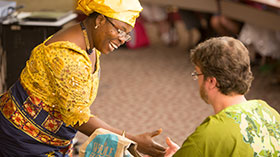 “And then for the women, so many women still used most of the herbal remedies from their grandmothers and great-grandmothers. Even though they had access to clinics, they said they just knew that practices of their ancestors worked and there wasn’t any reason to go pay a doctor’s fee when you knew that these things were taking care of it.”
“And then for the women, so many women still used most of the herbal remedies from their grandmothers and great-grandmothers. Even though they had access to clinics, they said they just knew that practices of their ancestors worked and there wasn’t any reason to go pay a doctor’s fee when you knew that these things were taking care of it.”
Abidogun said Igbo women are responsible for taking care of their daughters after they give birth; and the practices they use to prevent bleeding or hemorrhaging is nearly identical to Western medicine practices. In addition, indigenous herbs are used that support these practices.
“Women traditionally hold a significant amount of medical knowledge, even if they’re not officially herbalists,” she said. “Out of the people that I interviewed both this time and some interviews that I did in 2004-05, any adult woman could give me the basic remedies for malaria or dysentery. They knew the basic properties of several herbal plants – like for stomachaches you use lemon grass.
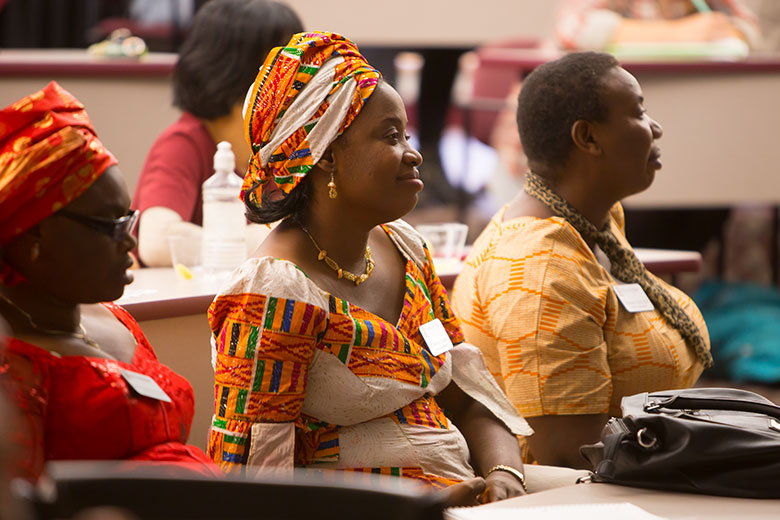
Indigenous knowledge does not lead to formal education
Despite the fact that many Igbo women and girls know a great deal about medicine and agriculture, Abidogun said the number of girls who study hard sciences – such as chemistry, biology, physics or astronomy – is very low.
“The education system is really strong in terms of the hard sciences, but the integration of indigenous knowledge is really lacking because, just like a lot of other cultures, ours included, people tend to think of it as folk lore.” — Dr. Jamaine Abidogun
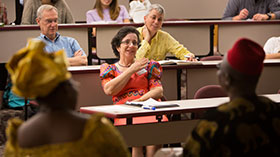 Abidogun and her colleagues from Missouri State and the University of Nigeria are developing curriculum that would incorporate indigenous knowledge into the teaching of hard sciences. They are optimistic that their recommendations may be implemented by the Enugu State Board of Education.
Abidogun and her colleagues from Missouri State and the University of Nigeria are developing curriculum that would incorporate indigenous knowledge into the teaching of hard sciences. They are optimistic that their recommendations may be implemented by the Enugu State Board of Education.
“I really hope and I think that we’ve made some of the right contacts to, one, integrate as much indigenous science as possible into the national science curriculum for Nigeria,” said Abidogun. “Then, two, see that the historical gender assignments are talked about and included in that curriculum so that girls in particular, but also boys, have a respect for the fact that science is for both genders.”
Communication professor turns childhood curiosity into passion for conflict resolution
Missouri State professor Dr. Charlene Berquist hopes to offer victims, offenders and other at-risk youths the opportunity to build the skills needed to pull themselves out of a justice system that may swallow them up.
“We’re loud and we’re boisterous. When there’s a conflict, we yell and deal with it, and then we hug and make up.” — Dr. Charlene Berquist
 Her passion for this work started as an inquisitive fourth grader.
Her passion for this work started as an inquisitive fourth grader.
At that time Berquist recognized not all families argued like her own. “We’re loud and we’re boisterous. When there’s a conflict, we yell and deal with it, and then we hug and make up.”
The idea that other families react differently sparked a curiosity that would endure as a communication scholar and as director for the Missouri State’s Center for Dispute Resolution (CDR).
Center for Dispute Resolution analyzes long-term effects of mediation
As director, Berquist is uniquely positioned to study the effects of conflict resolution programs, for both participants and facilitators. The center, serving as a laboratory of sorts with students, staff and volunteers, gathers research data throughout the mediation process.
“I would describe my research as being very qualitative. Typically I’m more interested in interviews and focus groups and the ‘why’ about research. Not just, ‘Am I satisfied with this program?’ But, ‘Why am I satisfied? How do I understand the experience?’”
The center’s mediation services, such as the Circles for Girls and Restorative Justice programs, were based on needs identified by its community partners. Berquist’s team used existing research to develop each program and distinguish research components to be analyzed, making tweaks over time based on the resulting data.
“We’re asking some fairly cutting edge questions,” she said. “I’m also interested in how particularly at-risk kids understand those experiences and how they apply what has happened in that program to their lives.”

Circles for Girls helps area teens build skills, self-esteem
Radical changes occur in pre-teen and teenage girls and the difficult transition into adulthood can lead to unhealthy relationships, body image issues and substance abuse. Area schools identify those struggling youths, aged 12 to 17, referring them to the CDR to meet with facilitators in groups of four to 10 for up to 10 weeks. Through skill-building exercises and journaling, the center hopes to impact social, emotional and physical well-being.
“…we had examples of girls, two or three years down the road, who remembered what their facilitators had said in journals to them that had a real effect on a choice they made or a different trajectory in their lives.” — Dr. Berquist
Berquist said the CDR has made some amazing discoveries, including improvements to the participants’ grades and that families often continue to use communication skills gained.
“I think most striking was that we had examples of girls, two or three years down the road, who remembered what their facilitators had said in journals to them that had a real effect on a choice they made or a different trajectory in their lives.”
Restorative Justice programs provide closure, accountability
Offenders rarely meet or speak to victims face-to-face; they are punished and put in the system with little to no rehabilitative support. Victims are left wondering why them and what kind of person would hurt another. Through its Restorative Justice programs, the CDR attempts to facilitate that closure and accountability between victims and offenders.
“…it was the first time they had really thought about a different way to react to someone doing something bad to them….” — Dr. Berquist
First- and second-time juvenile offenders are paired with their victims or community volunteers who have been victims to discuss the impact of the crime. Berquist said the offender’s observations of victims’ reactions have been interesting.
“Kids described that it was the first time they had really thought about a different way to react to someone doing something bad to them — not just lashing out at that person, but forgiving them or acting in a different way.”
CDR paves the way for more conflict research
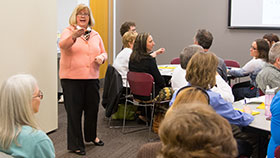 Through these discoveries, Berquist said the CDR continues to make changes to accommodate future participants. In addition, she noted that they are also analyzing data about how the process affects facilitators.
Through these discoveries, Berquist said the CDR continues to make changes to accommodate future participants. In addition, she noted that they are also analyzing data about how the process affects facilitators.
“Because we’re doing so many different kinds of programs here, we present at conferences and write about what our experiences have been like in doing these programs, and hopefully other people can learn from both some of our successes but also some of our mistakes.”
What’s so serious about child’s play?
Dr. Joanna Cemore Brigden, associate professor of childhood education at Missouri State University, is committed to emphasizing the importance of play for children.
As a woman of many appellations, Brigden is most proud of her title as play researcher. She teaches outdoor play classes at MSU along with the graduate course, Life as Play, which teaches students the importance of giving children time to play, explore, create and imagine.
“The problem for us in the U.S. is we don’t have a lot of ‘play’ in school anymore, coupled with a reduction in free play outside of school. That’s a really huge concern of my research and advocacy efforts.” — Dr. Joanna Cemore Brigden
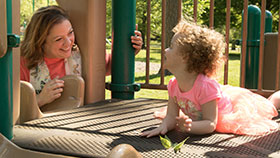 Brigden is currently the Association for the Study of Play book review editor, an international organization of play scholars. In addition, she is also on the board of the International Play Association (IPA). The IPA’s purpose is protection, preservation and promotion of the child’s right to play as a fundamental human right.
Brigden is currently the Association for the Study of Play book review editor, an international organization of play scholars. In addition, she is also on the board of the International Play Association (IPA). The IPA’s purpose is protection, preservation and promotion of the child’s right to play as a fundamental human right.
“IPA works cooperatively with organizations through the UN in the service of children’s right to play throughout the world. This can range from research and advocacy in schools to facilitating play in war torn areas of the world or escaping slavery and trafficking,” said Brigden.
Brigden is currently working on a project studying outdoor play in a more compact, indoor urban play space, and she’s looking at it from a child’s perspective.
“It’s important to know how children view play in order to create a workable space for them,” said Brigden. “This is also a great way to determine how emotionally intelligent children are these days.”
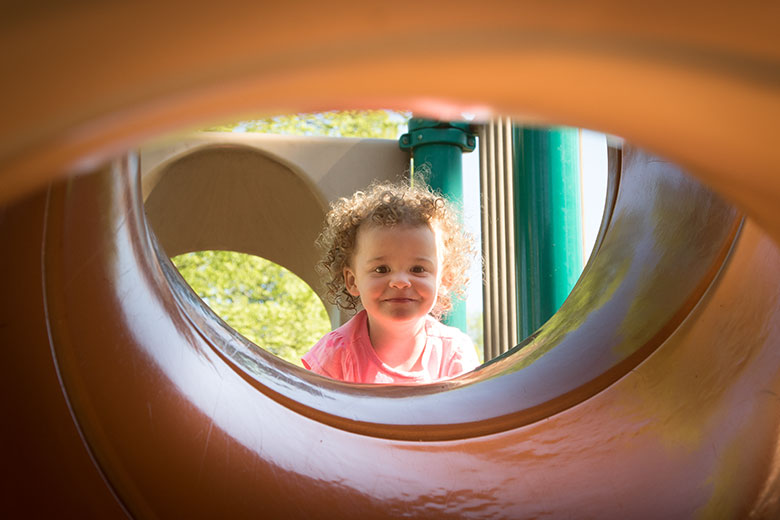
Brigden strives to educate community on the importance of foster families
Her interests go beyond fun and games; she has a passion for improving the lives of children which also includes parent and teacher education and advocacy for greater community resources.
Brigden and Deanna Hallgren, director of the Missouri State Child Development Center, recently received a grant from the Department of Elementary and Secondary Education (DESE) to enhance childcare, improve services and provide training for professionals who work with foster parents and children. In the training, teachers receive information specific to the needs of foster and adopted children in the classroom.
Brigden, who is also a foster parent, believes teachers sometimes do not understand the struggle it is for a child to uproot their lives and behave normally after joining the foster system.
“The goal we are trying to achieve with DESE is for all children to be ready to learn,” said Brigden. “If an child would not be ready to learn, it would be a foster child whose world has been completely turned upside down in a new house and possibly a new school.”
 Get moving: significance of interactive play
Get moving: significance of interactive play
The relationship between play and emotional intelligence caught the attention of producers for the children’s program and off-broadway show “The Ohmies.” They enlisted the help of Brigden in constructing a social and emotional curriculum for one of their shows, which incorporate imagination play, yoga and dance to get children out of their seats and using their bodies to have fun.
Solving real-world problems with high-level math
Rebaza, professor of mathematics, teaches numerical analysis and applied mathematics at Missouri State. His recent research interests range from showing how your brain processes language to exploring a way to predict the spread of waterborne diseases.
“The work we’re doing is important”
 Math professionals usually specialize in one of two areas. One is pure mathematics, which is largely abstract, and done for the sake of deeply exploring mathematics and constructing general results. The other is applied mathematics, which uses concepts from pure mathematics to solve problems and develop math tools for science, industry, business and other areas.
Math professionals usually specialize in one of two areas. One is pure mathematics, which is largely abstract, and done for the sake of deeply exploring mathematics and constructing general results. The other is applied mathematics, which uses concepts from pure mathematics to solve problems and develop math tools for science, industry, business and other areas.
“Mathematicians can get lost in the beauty of pure mathematics…” — Dr. Jorge Rebaza-Vasquez
Rebaza, professor of mathematics, teaches numerical analysis and applied mathematics at Missouri State.
“Mathematicians can get lost in the beauty of pure mathematics — many of us do not properly explain why the work we’re doing in pure or applied mathematics is important to society.”
He uses applied mathematics to collaborate with faculty colleagues both on- and off-campus, and often has students involved.
“We believe students don’t have to be in their master’s or PhD studies to do high-level research.”
Math is at the heart of research projects
So you have a research project, and have gathered some quantitative data — which is any information that can be measured with numbers. What do you need next? Mathematical modeling, Rebaza said.
“If you don’t have some of the tools needed to help you solve the given problem, mathematicians can create those. This is at the core of mathematics.” — Dr. Rebaza
These models help researchers interpret quantitative data. This allows them to next predict, and then verify, actions or results. And he is excited to share in such varied studies across so many disciplines.
What role does math play in the public health field? Rebaza shared that he is collaborating on a project mapping the spread of waterborne diseases, such as cholera and E. coli. Using multiple variables and parameters — such as the size of populations, the distance between those populations and the volume of water in the river that flows between those groups — Rebaza and some students developed and analyzed a mathematical model to predict how diseases will spread. It’s a complicated problem: They may need as many as 60 equations to determine the pattern of an outbreak.
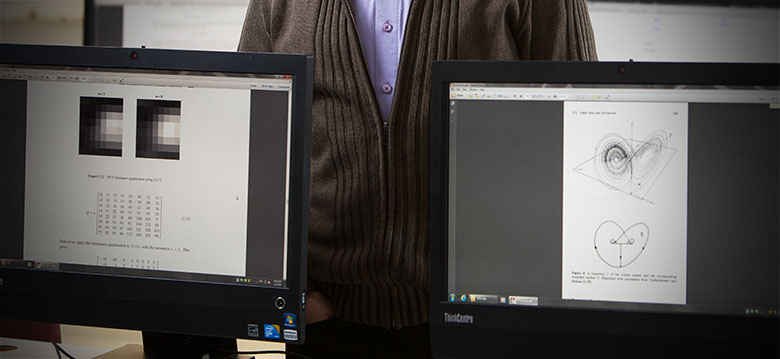
Dr. Erin Buchanan, associate professor of psychology at Missouri State, collected data showing that the brain reacted at different speeds to words that were related versus words that were not.
“I wondered about some cool, interesting ways to analyze this data,” Buchanan said. “I contacted the math department, and he was interested in using the numbers in a class.”
Rebaza and his students came up with a curve model to more precisely measure how much faster or slower the brain reacts. “We wrote a short program to come up with the answers they wanted,” he said.
Across the world, a geology professor in Germany wanted methods to accurately approximate the gravitational potential energy of the Earth. Rebaza was happy to help, even as he was working on a project to develop algorithms to more precisely and more rapidly predict how a search engine will rank various websites. Meanwhile, he also agreed to a photography-related project that uses cosines to determine how much an image can be compressed before the human eye starts to detect oddities in color frequencies.
Bringing top math minds to MSU
Rebaza doesn’t just work with Missouri State students. For six years, he and other MSU math professors have been involved with a National Science Foundation sponsored program called Research Experiences for Undergraduates in Mathematics.
Each summer, nine students from universities across the country come to Missouri State for eight weeks to work on cutting-edge research.
“These are the best-of-the-best undergrads.” — Dr. Rebaza
Becoming a host school for this program is competitive; only about 50 schools in the nation have hosted. In some cases, the undergraduates who participate at Missouri State transfer to MSU, or come here for graduate studies.
Rebaza, who grew up in Peru, earned a master’s degree in Germany and a PhD from Georgia Tech. He has been working at MSU since 2002, and is happy to mentor students from all around the nation.
“This grant has been a wonderful gift for our department and MSU — now we’re on the same page with many other big mathematics schools.”
Logos, layouts and logistics: Franchising in today’s market
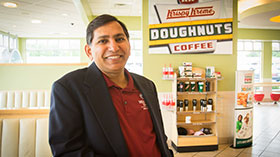 “Most people think of franchising as an industry, but the fact is that franchising is actually not an industry; it is a business model,” said Garg. “Franchising is everywhere. It’s in education, hospitals, aviation training and even interior decoration.”
“Most people think of franchising as an industry, but the fact is that franchising is actually not an industry; it is a business model,” said Garg. “Franchising is everywhere. It’s in education, hospitals, aviation training and even interior decoration.”
Over the years, Garg conducted most of his research in franchising, particularly multi-unit franchising, by surveying more than 100 franchises in various fields. The results provided Garg with enough information to create statistical models that explain the success of multi-unit franchising. But surveying comes with its own challenges, so he also employs triangulation.
“Franchising is everywhere.” — Dr. Vinay Garg
“Essentially, triangulation is the use of various methods to come to a similar result to ensure a one-time result is not generalized across different populations and settings,” says Garg. “For example, a respondent may say only good things in order to be looked favorably upon or avoid pulling down their image or that of the company. By using published records in combination with survey data and interviews, we are provided with a more accurate picture.”
Garg has had his research published more than 20 times since 2000, a testament to his dedication and findings concerning franchising.
The basic business model
So what is franchising? When an entrepreneur is looking to start their own small business, they have the option to buy a franchise. With a franchise, the franchisee will follow established procedures that have previously been proven successful and pay regular royalties to the franchisor.
“Instead of the franchisor having a 500-restaurant chain, they can make 5,000 or 10,000 in the same time because they don’t have to invest their own money or task their managers with the job of building one restaurant at a time,” said Garg. “McDonald’s has over 36,000 franchises in 100 plus countries. More than 80 percent of McDonald’s restaurants worldwide are franchised. Each day a new franchisee is building a store somewhere in the world, but McDonald’s is free from having to invest and worrying about the nuts and bolts of creating and operating it.”
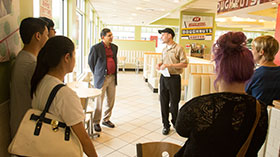 Franchises can be a great opportunity for entrepreneurs looking to start their own business without the hassle (or struggle) of the trial-and-error that comes with starting a business from scratch. In addition, franchises benefit from the name recognition that comes with a well-established brand.
Franchises can be a great opportunity for entrepreneurs looking to start their own business without the hassle (or struggle) of the trial-and-error that comes with starting a business from scratch. In addition, franchises benefit from the name recognition that comes with a well-established brand.
There are some drawbacks, though. Franchising doesn’t allow much, if any, creative freedom, and franchisees often feel undue pressure to offer deals that can reduce their profit margins. Franchisees are also required to enter into a contract that includes strict guidelines for things like marketing and operations.
“Let’s say a person who owns a McDonald’s starts selling cakes or cookies at their store and the quality is poor,” said Garg. “Then McDonald’s pays the penalty. Although it had nothing to do with McDonald’s typical menu items, its brand gets tarnished. So, strict contracts allow franchisors to avoid these sorts of issues and control the behavior of franchisees.”
The future of franchising
Though Garg has examined many issues over his years researching franchising, this is only the tip of the iceberg. Garg is delving into research about new forms of franchising, such as store-within-a-store (a Subway within a Patriot gas station) or a small food court comprised of many brands (such as Taco-Bell, KFC and Pizza Hut) owned by the same corporation (Yum Brands) within one location.
“It will be interesting to discover what the challenges are in new approaches to the franchising business model,” he added.

ACT now to avoid depression and anxiety
Rost discovered that late-stage ovarian cancer patients achieved a better quality of life when they participated in a modern therapy called Acceptance and Commitment Therapy (ACT) rather than traditional therapy. By learning to accept difficult thoughts and emotions, the women were better able to cope with their situation and less likely to suffer from anxiety and depression. Rost worked with MSU Associate Professor of Psychology Dr. Erin Buchanan and researchers from the University of Mississippi, University of Nevada-Reno and Washington University Medical School on the project.
Rost became interested in ACT her last year in graduate school at the University of Kansas, when she was working with patients with cancer and chronic pain conditions. The traditional therapy at the time focused on patient behavior and changing the content of thoughts.
“There was nothing to change about their thoughts, as they were being realistic in their fears and concerns about their health conditions,” she noted. “Telling them to think differently about their situation felt like it invalidated their whole experience.”
Rost added that in the short run cancer patients might feel better avoiding thoughts and cues about their health status, but if they do not think about it, they miss out on opportunities to engage in meaningful activity such as spending time with family, addressing relationships, and investigating and planning health-care options and end-of-life outcomes.
Accept, commit, repeat
The first step Rost uses during ACT is to learn what strategies the patient has tried in order to cope with the situation and whether the actions have worked. If the individual still feels bad, Rost takes a values inventory to find out what is most important to the patient, and then she determines whether that person has been living in a way that matches his or her values. For example, if the relationship with the patient’s friends is most important, what is that individual doing on a day-to-day basis to build these bonds? Rost stressed that even if the individual feels sad or mad and being connected is hard due to deteriorating health, the patient must commit that this is what he or she wants.
“Most end-stage cancer patients move quickly emotionally and get in there and make changes in a hurry.” Dr. Rost
Rost recalls working with a patient who had end-stage ovarian cancer and was married with kids living outside the home. The woman was so invested in never feeling bad that she put a towel over her head during treatment so she would not see other sick people. She stayed in her room and would not answer the phone, which cut her off from her social support and made her life “smaller.” ACT enabled the woman to have meaningful interactions with her family at a time when that really mattered.
Restoring a sense of self
Referring to Rost’s research, Dr. Bob Jones, Missouri State University psychology professor, said one of the few moments in people’s lives when you can make changes in the way they see themselves and treat those around them is when they have cancer.
“Cancer changes everything for all of us. We are faced with our mortality. Managing this transformation can be incredible. People are able to be who they are, living to their full potential.” — Dr. Bob Jones
Kirby Williams, an MSU graduate student in clinical psychology from Grove, Oklahoma, shares Rost’s interest in health psychology. Rost helped Williams with the research for her senior honors thesis on diabetes care management in undergraduate college students. After working with Rost as an undergraduate student, Williams plans to pursue a Ph.D. in psycho-oncology.
“Dr. Rost cares about community and is passionate about health. She wants to make a difference in people’s lives. I am lucky to have found her,” she said.
Fiction to fact: Researchers advancing artificial intelligence
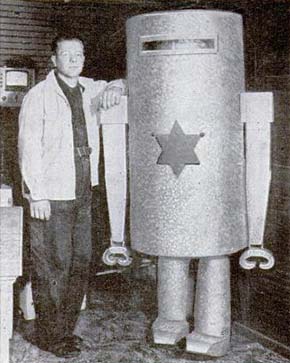
Younger’s inspiration — his dad, Reat — was featured in Popular Mechanics in 1948 with a robot he built.
Science fiction writers from Issac Asimov to Roger Zelanzny have written about the coming age of robots and artificial intelligence for many years. Generations of viewers raised on “Star Trek,” “Star Wars” and even “The Jetsons” grew up expecting our world to be eventually populated by intelligent machines doing many of the mundane tasks for us.
Believe it or not, two Missouri State researchers are actively working to make that vision a reality. Dr. A. Steven Younger, applied science and engineering research professor, and Dr. Emmett Redd, physics, astronomy and materials science professor, are directing their research efforts toward developing machines with more brain-like intelligence and capabilities.
Younger and Redd believe that, despite the capabilities of modern computers, their research could contribute to the development of an advanced machine with a knack for common sense and the ability to learn well beyond the parameters of its programming.

Pursuing brain-like flexibility
Research for this project is being completed in conjunction with Dr. Hava Siegelmann, professor of computer science at the University of Massachusetts–Amherst, with financial assistance from the National Science Foundation. Siegelmann’s work focuses on neural networks, circuits designed to mimic neurons connected by synapses. The system could theoretically result in incredible computing power. Redd and Younger were aware of her work before realizing their research was moving in the same direction.
“We are trying to build a machine that can make computations a standard Turing machine (the model for a standard digital computer) can’t. We are particularly interested in machines that have properties that are important for more brain-like, intelligent capabilities: learning, adaptability, pattern-recognition robustness and flexibility.” — Dr. Steve Younger
The approach the researchers have taken involves a chaotic system, which is very sensitive to small changes. This analog system can react to bigger and smaller changes, which can feedback to cause other bigger and smaller changes. The system, therefore, becomes driven by unpredictable and extremely variable noise, which Younger and Redd are convinced creates the less rigid approach of a chaotic-neural network and is more likely to lead to more brain-like intelligence.

Differences between analog and digital
Most people know that digital is a binary system based on combinations of “1” and “0.” An analog system, however, includes all the space between. This approach sacrifices the ultra-precision of digital computation for a more complex and flexible process. The random nature of an analog process can lead to mistakes, which just might be a good thing, since the machines could learn from these mistakes and be less likely to make the same errors later.
Redd elaborates: “A car can’t fly; an airplane can, although they share many of the same components. We’re trying to build components and designs that allow us to go beyond what the Turing machine offers.”
In addition to the inherent complexity of a super-Turing machine, there are also size and power advantages. “We are reaching size and power limitations of digital computers,” Redd said.
“Think about Google’s search computers; they aren’t as powerful as the human brain and yet the brain operates on far less power.” — Dr. Emmett Redd
The practical applications from this research are potentially vast. “Probably the biggest application would be pattern recognition and robotics,” said Younger. “We can see where there could be an analog computer that could talk together and work together with a digital computer, because there are several things that digital computers are so good at.”
Why the weekly spelling test doesn’t stick
During his third grade year, Masterson noticed her son was still having a hard time making his marks on his spelling tests despite extra study time. Again, she spoke with his teacher and received the same response as the teacher from the year before: “Oh that’s normal. He’ll learn.”
Masterson refused to accept the idea that individuals could not improve a skill.
She dropped the subject for a second time and continued to help him study at home. As he later progressed in the fourth grade, his teacher noted his poor spelling skills but said that nothing could be done about it because, “people are either good at spelling or they aren’t.” As a speech-language pathologist, Masterson refused to accept the idea that individuals could not improve a skill. She had indeed observed her son’s struggle to spell words, but she had also spotted something else: He was a very strong reader despite his poor spelling skills.
Why was this? This question motivated Masterson for the next 20 years as she researched literacy development in young children. Her findings suggested that the way in which we teach our children to spell may be wrong.
What is spelling awareness?
“How were we taught to spell? Most of us were given a list of words on Monday that we had to study at home, memorize really, throughout the week and then we took a test on Friday,” said Masterson. “What we’ve initially found in our research is that spelling isn’t dependent on memorizing. It may work for the Friday test, but kids will go back to spelling the words the way they did after that.”
Masterson found that in order to learn how to spell, you need three things: sound awareness, meaning awareness and spelling pattern awareness.
Using the word “burned” as an example, the reader must know that “burned” has four sounds, and this is sound awareness. They must also know that “ur” sound can be spelled a variety of ways, such as “-er” or “-ur,” and this is spelling pattern awareness. But what about meaning awareness?
“How were we taught to spell? Most of us were given a list of words on Monday that we had to study at home, memorize really, throughout the week and then we took a test on Friday.” — Dr. Julie Masterson
“When you hear the word ‘burned’ the last two sounds in that word are the ‘n” and the ‘d’ sounds,” said Masterson. “Well because you know that the word refers to an event that occurred in the past, you know not to just end that word with a ‘d;’ you know to spell it with an ‘-ed.’”
After readers have successfully mastered all three features of spelling a word or set of words, they must develop automaticity. Automaticity is the ability to know how a word is spelled without having to go through its three features. It involves having clear “mental pictures” of words and allows a reader to instantly recognize a word or a writer to automatically spell a word.
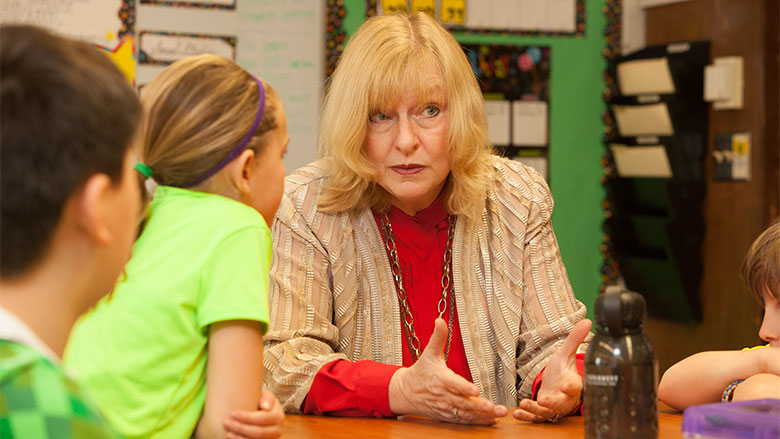
Improving both spelling and reading
In order to define exactly what it is kids need to learn and how best to teach them, Masterson designed tailored interventions based on how children spell various types of words. She and her collaborators (including many MSU students) developed software to analyze spellings and indicate goals and methods for treatment as well as a metric to monitor student progress. The team conducted treatment studies and found that the children’s spelling did get better, but their reading improved to an even greater extent. Improvement in reading is particularly important in an era of school accountability.
With this metric, they’ve been able to do several group comparisons on children from various backgrounds, including kids of aboriginal descent in Australia and those who are African American versus not African American. They also tested children who were living with certain conditions like speech disorders or deafness.
“People would have assumed that if you were deaf for a number of years, your spelling errors would be primarily due to a lack of awareness of sounds because you weren’t hearing them…Yes, some of them were, but a lot of them were just like errors in people who are hearing yet have failed to learn the necessary spelling features. The good news is that our tailored treatment can be used to help them learn what they need to learn.”
Lost? Here’s a map for early literacy development
 The three spelling features and more are discussed in Masterson’s newly-revised book “Beyond Baby Talk: From Speaking to Spelling: a Guide to Language and Literacy Development for Parents and Caregivers.” Co-authored with Dr. Kenn Apel and sponsored by the American Speech-Language-Hearing Association (ASHA), the book provides parents with the resources necessary to properly monitor their child’s development from infant to the third grade. Masterson had no intention of writing a book, but when she was approached by the executive director of ASHA she quickly saw the topic’s potential for a wider audience. Her expertise on the subject and second edition of the book led to her being featured in articles for NBC’s “Today Show” about how to tell the difference between normal developmental variation and potential disorders, gender differences in language development, and how to teach young children to be kind.
The three spelling features and more are discussed in Masterson’s newly-revised book “Beyond Baby Talk: From Speaking to Spelling: a Guide to Language and Literacy Development for Parents and Caregivers.” Co-authored with Dr. Kenn Apel and sponsored by the American Speech-Language-Hearing Association (ASHA), the book provides parents with the resources necessary to properly monitor their child’s development from infant to the third grade. Masterson had no intention of writing a book, but when she was approached by the executive director of ASHA she quickly saw the topic’s potential for a wider audience. Her expertise on the subject and second edition of the book led to her being featured in articles for NBC’s “Today Show” about how to tell the difference between normal developmental variation and potential disorders, gender differences in language development, and how to teach young children to be kind.
Metals move front and center to target cancer
“In our household was a jar of water at the table. In it was an old Czar Russian silver ruble at the bottom — a pure silver coin. That silver leeching slowly out in the solution provided pretty good sterilization of water.”
 The antimicrobial property of silver is one key to a current research project Gerasimchuk is conducting 30 years after receiving his first doctorate degree in Kiev, Ukraine. He is developing a set of compounds that, when added in a small amount to light-curable polymeric medical adhesives, could be used to properly set medical indwelling devices and prevent infections at those sites. This coating mixture, which is also water insoluble, light insensitive and thermally stable to withstand the rigors of medical and dental procedures, is patent pending and not available yet. Gerasimchuk envisions a day, though, when it will be used with pacemakers, joint replacements and in dental implants.
The antimicrobial property of silver is one key to a current research project Gerasimchuk is conducting 30 years after receiving his first doctorate degree in Kiev, Ukraine. He is developing a set of compounds that, when added in a small amount to light-curable polymeric medical adhesives, could be used to properly set medical indwelling devices and prevent infections at those sites. This coating mixture, which is also water insoluble, light insensitive and thermally stable to withstand the rigors of medical and dental procedures, is patent pending and not available yet. Gerasimchuk envisions a day, though, when it will be used with pacemakers, joint replacements and in dental implants.
“What we are hunting for is to make that interface between tissue and any indwelling device antimicrobial. Because what happens in many cases is that infection comes in place where the device is set, and we know what that means: The loss of productive lifetime, increased post-procedural rehabilitation and recovery time, pain and significant material cost needed to address the problem. ”
“The more I was doing this work, the more I realized how beautiful this group of molecules is.” — Dr. Nikolay Gerasimchuk
The common thread between each of Gerasimchuk’s research projects is a subclass of organic compounds that he discovered called cyanoximes. These compounds bind metal ions strongly and have many characteristics depending on what they’re bound to.
“The more I was doing this work, the more I realized how beautiful this group of molecules is,” he said. “I saw an opportunity to build a tinker toy, a Lego type approach, so we can keep one part of the molecule consistent and then add a huge variety of other parts to it to change the compounds’ properties such as solubility, bulkiness, color, etc.”
That’s exactly what he’s doing with his two other research projects, both of which also have medical applications.

Fighting cancer with palladium compounds
Many of the primary anticancer drugs are platinum based, Gerasimchuk explained, which poison every cell they encounter. These drugs work because cancer cells divide much faster than non-cancerous cells, and blocking that division cycle is one of the main tactics in the fight. But tumors build resistance to this type of drug. To improve the effectiveness of these drugs and alleviate side effects in cancer patients, Gerasimchuk is designing compounds structurally similar to these anticancer compounds and making them more water soluble by binding these substances to specifically designed cyanoximes.
He is also working to develop anticancer active compounds using cyanoximes with palladium, platinum’s neighbor on the periodic table.
“Palladium is much less toxic and much less expensive, so we are testing whether we will persistently see slightly better activity of our new palladium compounds compared to those with platinum. If so, then we can push for a new type of drug.”
Platinum compound used to find, fight cancer
 Approximately 15 years ago, a new scientific field was created called theranostics — a combination of therapy and diagnostics. It’s still being explored, and Gerasimchuk is contributing by designing and making platinum cyanoximes complexes to find tumors and ultimately act as anticancer agents.
Approximately 15 years ago, a new scientific field was created called theranostics — a combination of therapy and diagnostics. It’s still being explored, and Gerasimchuk is contributing by designing and making platinum cyanoximes complexes to find tumors and ultimately act as anticancer agents.
Visualize a stack of poker chips with platinum centers. The stacks are flexible and loosely connected by a thin thread down the center of the stack. Electrons move along the thread, and as they move, they can absorb light in visible region of spectrum and re-emit it in the near-infrared region.
“What we would like to do is to put these compounds inside of cells or tissue. Since they emit light at this very specific range of wavelengths (near-infrared), it comes through tissue without being absorbed,” he explained.
For this project, Gerasimchuk partnered with Dr. Mikhail Berezin from Washington Medical School’s department of radiology, who built a $1 million piece of equipment that allows scientists to view in the near-infrared range. Their work on this theranostics project was published in the January 2015 issue of the American Chemical Society’s journal, Inorganic Chemistry.
With Berezin’s equipment and the patent-pending new infrared emitters, doctors could diagnose and target cancer cells.
“Once the compound disassembles due to metabolic processes, it acts as an anticancer agent and kill cancer cells. That is a very cool application!”
Learning laws and loopholes in the information age
“My training has got me scared to do any of that,” chuckled Anderson, professor in the department of finance and general business.
Anderson, who jokes that he’s been on campus forever, was practicing law in the state of California when he became interested in the issues of software development and started writing articles on the topic from the legal perspective. After teaching business law at Missouri State for more than 20 years, the computer information systems graduate program coordinator recruited Anderson to teach a course on legal issues in the information technology arena – a course that changes each semester due to new issues and nuances that appear.
“Anything that’s older than three years, four years, is ancient history in this area of law.”
“I am not in it to create junior attorneys. Instead, it’s my job to put an alarm system in you so that maybe you don’t remember what the law is from what we talked about, but you smell a rat in this,” he said.
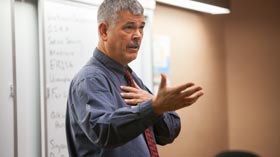 The students in his courses are often IT professionals, working toward an advanced degree, so they bring forward research topics for articles and discussions that are applicable to their daily lives. Anderson works closely with those students to produce articles for publication on a variety of topics affecting the IT industry, ultimately co-authoring 19 articles in the last seven years.
The students in his courses are often IT professionals, working toward an advanced degree, so they bring forward research topics for articles and discussions that are applicable to their daily lives. Anderson works closely with those students to produce articles for publication on a variety of topics affecting the IT industry, ultimately co-authoring 19 articles in the last seven years.
“It’s phenomenal how many I’ve been able to get published for them. That’s nice for everybody.”
Can you keep a secret?
“I wish there was a silver bullet for spoofing. Backtrack to see if it’s really coming from who you think it’s coming from. Always use throw away e-mail addresses when corresponding with an unfamiliar source. Have a separate banking account for questionable transactions. Just use a little precaution.”
Much of the course work focuses on intellectual property issues, including patents, copyright, trademarks and trade secrets. Anderson also addresses contracts, criminal law, hacking and spoofing.
“It’s getting to be very difficult to keep anything secure,” said Anderson. “Of course, you clicked on the ‘I Agree’ button or you wouldn’t even gain access to many of these sites from day one. Before you clicked, you failed to look at the 32 page document that covered that.”
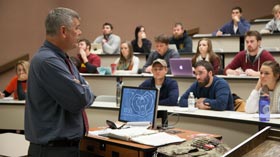 With intellectual property, Anderson stressed how time-consuming and monetarily expensive it can be to protect a product or service. The owner must also be willing to bring the action to court.
With intellectual property, Anderson stressed how time-consuming and monetarily expensive it can be to protect a product or service. The owner must also be willing to bring the action to court.
“A lot of people assume that if there’s infringement, someone else – like a governmental agency – will step in to enforce it.” That’s the exception rather than the rule, he pointed out.
So as a lawyer, mentor and researcher, Anderson feels compelled to stay abreast of the latest regulations in the technological industry, which helps to influence discussions with his students. He delves into the morality of the actions and whether a law exists to influence a decision.
“Sometimes, I want to tell my students how to protect themselves from the people that they work for, as well as protect the people that they work for,” he said. “Because, when things hit the fan, unfortunately, sometimes the company will be looking for someone to be held responsible.”
More about Wayne Anderson
Father of 3, one’s a doctor at Mayo Clinic; twins (25), male in law school at William and Mary, female at UC-Davis working on economics and textiles “undoing all the damage my son and I did from law school”
Memberships
- Member of the State Bar of California
- Member of the American Bar Association
- Member of the American Bar Association Business Law Section
- Member of the Midwest Academy of Legal Studies
- Member of Beta Gamma Sigma (Business Honor Society)
- Member of Phi Delta Phi (legal)
- Member of Phi Eta Sigma (National Honor Society)
Honors and awards
- Most Knowledgeable, and Invigorating Award
- Most Inspirational Award
- COBA Excellence in Teaching Award
- Professor of the Year
- University Thoughtfulness and Professionalism Award
- Most Effective Award at Annual Teachers Appreciation Day
- Most Knowledgeable Award at First Annual Teachers Appreciation Day
Adding significance to the seemingly mundane

“If you’re an artist, you’re either a hedgehog or a fox. … I’m totally a hedgehog.” — Sarah Williams
Occasionally, she gets taken down to the police station on her quest to capture images of her subjects, but usually in her small hometown of Brookfield, Missouri, where she photographs most often, they recognize that she’s on a mission.
 “I’m working from these terrible little snapshots that I take, and I love for them to be bad because it makes me be inventive,” Williams said.
“I’m working from these terrible little snapshots that I take, and I love for them to be bad because it makes me be inventive,” Williams said.
From these resource shots, she knows the shape of the building and location of the light source, but she adds in detail and color – color is her passion – to showcase these buildings’ unique structures.
“I’m just really fascinated with how you can indicate the way of life or someone’s existence or personality through the way they’ve built whatever it is they use,” she said.
Coping with homesickness through painting
Growing up in rural Missouri has influenced Williams’ art from her earliest memories. In fact, the only art she remembers from childhood was that of the waiting room variety, and the pictures she drew of wildlife.
After moving to the Dallas metro area for her graduate work, she began taking photos on her home visits and putting this inspiration on canvas.
“I was having this crisis because I didn’t recognize anything, and I’ve always grown up in a small area where I could go by landmarks…I completely lost my sense of place.”

Through her paintings, she started to share the uniqueness and slower pace of the rural way of life, sometimes through an abandoned highway or a dark night sky against an aging industrial building.
Recently she’s begun incorporating more residential settings into her work and experimenting with the feeling of voyeurism. For her, she’s trying to capture the feeling that the viewer is standing on the sidewalk staring at the houses to see what is visible inside.
“I’ve got this series of small houses with big picture windows, and you can see the giant TVs glowing through the windows, so there’s that acidic artificial light that’s happening.”
Open-air paintings are often created in a serene location to paint landscapes, but as a student, Sarah Williams did a series of open air paintings in the aisles of her hometown Wal-Mart.
“I was in the middle of Wal-Mart where everybody was doing their shopping, and I was painting from observation – the light on the linoleum, the displays, or the bananas were $1.60.” She remembers being met with questioning glances.
Exploring her subject like a hedgehog
 For a young artist, Williams has received a lot of recognition for her body of work. Her oil paintings were displayed at the Nicolaysen Art Museum in Casper, Wyoming, in spring 2014, and she showed at Northwest College in Powell, Wyoming, where she taught a course called Weekend in the Wild that took students to Yellowstone. In February 2015, she had her largest solo show to date in Houston, Texas, at the McMurtrey Gallery where she showed more than 30 pieces. She also was selected for a solo show at the George Billis Gallery in Los Angeles in September 2015 and at the Talley Dunn Gallery in Dallas in January 2016.
For a young artist, Williams has received a lot of recognition for her body of work. Her oil paintings were displayed at the Nicolaysen Art Museum in Casper, Wyoming, in spring 2014, and she showed at Northwest College in Powell, Wyoming, where she taught a course called Weekend in the Wild that took students to Yellowstone. In February 2015, she had her largest solo show to date in Houston, Texas, at the McMurtrey Gallery where she showed more than 30 pieces. She also was selected for a solo show at the George Billis Gallery in Los Angeles in September 2015 and at the Talley Dunn Gallery in Dallas in January 2016.
“If you’re an artist, you’re either a hedgehog or a fox,” said Williams. “If you’re a fox, you’re jumping all over the place with your concept and your materials…If you’re a hedgehog, you’re working through new ideas, but it looks very consistent, so to the outside eye, it’s a slow, slow progression. I’m totally a hedgehog.”
To view selected works, visit http://sarahwilliams-paintings.com/.
Economics professors look for value in the night sky
In a time where the importance of outsourced goods is the topic of most economic discussions, the night sky has not had its due as an economic resource. That’s an issue economics professors Dr. Terrel Gallaway and Dr. David Mitchell hope to address.
Gallaway and Mitchell, along with professor Dr. Reed Olsen, have spent six years researching the question: what really is the overall economic value of the night sky? Assessing the value and importance of the night sky could mean millions more dollars for tourism industries and other key areas.

Gallaway and Mitchell, along with professor Dr. Reed Olsen, have spent six years researching the question: what really is the overall economic value of the night sky?
Today, the wonder of a clear night sky is threatened by the careless use of artificial light. Research shows about 25 percent of electricity that is produced in the U.S. is used for lighting and an estimated 30 percent of that is wasted as light pollution—about $25-30 billion dollars a year. The two Missouri State economics professors are looking to determine how much Americans are willing to do to address this dilemma.
The team conducted numerous surveys that ask average citizens questions like “how much do you think the night sky is worth?” and “how much would you pay to travel to this certain place?” in order to obtain an estimated value of dark night skies.
“Tourism turns out to be one of the most important industries concerning the night sky,” said Gallaway. “Typically national parks have something they are trying to protect, and what they are trying to protect is dark night skies.”
Gallaway and Mitchell focused their research on western national parks and areas like the Colorado plateau, where the sky is more pristine and there are more protected areas to incorporate in their research. This area of the U.S. brings in millions of dollars each year for travel and tourism and has huge potential because of its protected lands and views of the night sky.
“The night sky impacts wildlife, different types of flowers and trees and even migration,” said Mitchell. “If not protected, you’re in essence destroying half of the environment.”
 Along with the natural effects of the night sky, Gallaway and Mitchell have identified some health issues caused by the lack of it. Light often tricks the body into staying awake even if rest is needed, opening the door for major physical and mental issues to occur.
Along with the natural effects of the night sky, Gallaway and Mitchell have identified some health issues caused by the lack of it. Light often tricks the body into staying awake even if rest is needed, opening the door for major physical and mental issues to occur.
“It’s not just aesthetics,” Mitchell said. “The lack of an adequate sleep can lead to obesity, attention deficit hyperactivity disorder and even cancer.”
According to Mitchell, there is immense documentation that states when people don’t get good sleep at night, it interferes with their hormones. “In women, this could mean higher incidences of breast cancer,” said Mitchell. Other chronic conditions that could occur include diabetes, migraines and hypertension.
Though these health problems are preventable, determining the monetary value of the night sky may be a complicated task to accomplish. However, Gallaway and Mitchell don’t mind leading the way.
This research yielded the first grant the economic professors received from the National Park Service for this trail-blazing research. Although there have been studies conducted concerning the conservation of America’s natural resources, little to no research has been done focusing primarily on night skies.
“Within the social sciences, especially with economics, there hasn’t been very much research done on this topic at all,” said Gallaway, “which sort of makes us the pioneers in this field.”
Picking the right literature to counter aliteracy
Illiteracy is a concern for Dr. Sabrina A. Brinson, who advocates for learning those skills early and reinforcing often. But she is equally concerned about the plague of aliteracy – a term used to describe having the ability to read but lacking the desire and motivation.
Brinson is a Diversity Fellow and a professor of childhood education and family studies at Missouri State, and part of her response to this problem was the establishment of Boys Booked on Barbershops and Girls Booked on Beautyshops in 2004. These are community-based programs set up in neighborhoods and communities all over the United States. Professional organizations – currently more than 20 of them nationwide – partner with Brinson and locate a barbershop, beautyshop or other community location to establish a reading nook.
 Don’t clean out your garage to donate books to this great cause, though.
Don’t clean out your garage to donate books to this great cause, though.
She researches the demographics of the shops, communities, patrons and asks pointed questions about the abilities of children who visit the shop. She stays up to date with all the latest literature for children ages 1-18 and tailors the reading nook recommendation to the specific shop’s needs – all of this in hopes of making the books more engaging and interesting to the children and families who read while they’re waiting.
“How do I know it works? One of the most reinforcing things is that children want to take the books with them,” said Brinson.
While these nooks could be in any community the professional organizations wanted to sponsor, they often show up in more diverse communities. This fits right in with her three main research focus areas: diversity, multiculturalism and social justice with an emphasis in African American studies; culturally responsive literature; and the social, emotional and moral development of children.
“When people refer to diversity and culture, we tend to have tunnel vision,” said Brinson. Instead of diversity being synonymous with race and culture, it’s gender, socioeconomic status, religion, language, vernaculars, and so much more, according to Brinson.
In that vein, she looks at culturally responsive literature as a way to engage readers and improve literacy.
“It’s important for people of any culture to see positive reflections of themselves. But it’s also equally important for people to have views into the lives of others,” said Brinson.
One study Brinson conducted with teachers asked them to identify two books in their library that showcased a variety of multicultural and diverse characters as the main characters.
“Just two books – and they (the teachers in the study) couldn’t do it,” Brinson said. From that, she reasoned that the teachers were not incorporating diverse literature into their students’ studies, which could lead students to feel insignificant. “What it says to others – the ones who are represented in the story – it lulls them into a false sense of superiority,” added Brinson.
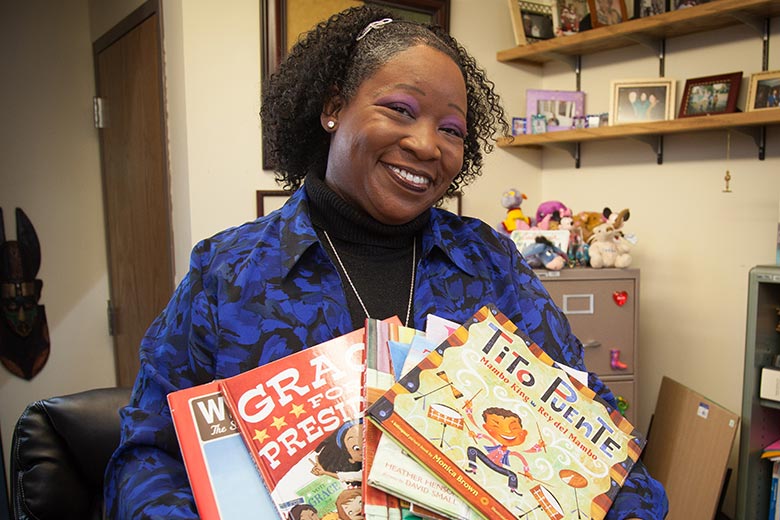
“How do I know it works? One of the most reinforcing things is that children want to take the books with them.,” – Dr. Sabrina A. Brinson
Bullying and stigmas
This sense of superiority can lead to horrific outcomes, like bullying. Brinson conducted research on females bullying males through interviews with 21-54 year old men who had been victimized in their younger years, often in the lunchroom and between classes.
“People are starting to say, ‘hey, our girls aren’t so sugary sweet and so nice,’” Brinson said. “Every single man I interviewed could recount those acts of bullying as if they’d happened yesterday.”
Through primarily mental abuse, the females gained control over the males they bullied, and the men recounted the emotional turmoil, the frustration of it being socially unacceptable to retaliate against a female, and the feeling of helplessness for fear that no one would believe them.
As part of a research team for positive behavior support, Brinson also helped establish a behavior change program at a Florida middle school for students in special education classrooms. The program – a self-monitoring program, which taught students how to stop themselves before they revert back into their disruptive behavior patterns – was developed to reintegrate the students into general education classrooms and to overcome the stigma that is often associated with special education.
The era of RNA research
Dr. Robert Delong, associate professor of biomedical sciences at Missouri State University, and his group of students are interested in Ribonucleic Acids (RNA) targeting, a very rapidly developing field in science.
“One of the things we are particularly interested in is a new branch of science called RNA nanotechnology and therapeutics,” said Delong, who was recently elected as the associate editor of “Reviews in Nanoscience and Nanotechnology.”
Like DNA, RNA can be manipulated and designed to produce a variety of different nanostructures. RNA, however, is a more flexible structure that can fold into numerous complicated configurations.
Chemists all over the world are producing nanomaterials out of almost all of the different elements in the periodic table. The nanomaterials made out of each of the elements can be a completely different beast; physically, chemically and biologically.
“Each one of the nanomaterials is like a different animal at the zoo,” Delong said. “Whereas you might have to cage the tiger, we want to have the pink flamingos out stretching their necks because they’re beautiful birds.”

Like DNA, RNA can be manipulated and designed to produce a variety of different nanostructures.
It’s possible that by combining nanomaterials with RNA, it provides a key to curing some cancer. Since these materials have never been created before in nature, scientists don’t know what they will do to life and life’s processes at the cellular and molecular levels.
“So the question now is, when the nanomaterials go into the cells, how do they affect the molecules, for example the many types of the RNA, within them?” said Delong. “How do they respond to the tiger versus the flamingo?”
A renewal grant from the National Institutes of Health’s National Cancer Institute gives Delong and his team the means to test different nanoparticles on various cancer cells. In fact, Delong incorporates these types of experiments into his graduate and undergraduate level curriculum.
“We’re taking these different nanomaterials derived from the bio-elements and we’re sprinkling them on cancer cells and trying to figure out how the cancer cell responds,” Delong said.
There are roughly 100,000 different proteins in our body and one of the biggest questions in molecular biology is how nanomaterials affect proteins and RNA in our cells.
Experts are excited to think that these nanomaterials could lead to a new wave of drug development. They believe nanomaterials could have the potential to revolutionize drug discovery and drug delivery.
“Biotechnology, it constantly seeks to improve health and the human condition,” Delong said. “At the end of the day we want to create things that can help make a difference in the world.”

